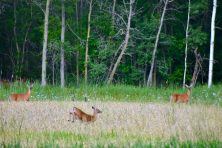WILD THINGS: No Shortage of Whitetails, but Ammo? That’s Another Story
- Share
- Tweet
- Pin
- Share

Department of Natural Resources (DNR) staff members talked all things white-tailed deer and answered questions from reporters across the state last week during a virtual media briefing on the upcoming gun deer hunting season.
Eric Lobner, director of the DNR’s Wildlife Management Program, said that somewhere around 875,000 licenses allowing bow, crossbow and gun deer hunting will likely be sold in Wisconsin this year. Fishing, with more than 1.3 million licenses sold, lures more people outdoors, but that’s spread out over 12 months. Although the various deer seasons are open mid-September into January, the bulk of the action takes place in November.
Hunters from all 50 states and 14 countries were represented in 2020, with an estimated economic impact of more than $2 billion.
Jeff Pritzl, DNR Deer Program specialist, said the early buck harvest is ahead of the five-year average in all four deer-management zones. Crop harvest is also ahead of schedule, and there’s less water restricting access. If the opening-weekend weather cooperates, he expects a solid gun hunt.
Pritzl said the annual November season is as much a cultural event for families and friends as it is about filling the freezer. Sitting in the deer woods can bring the greatest peace and serenity, he said, as well as the greatest adrenaline rush.
“Hunters are out there for both ends of the spectrum,” Pritzl said.
Deer populations after a mild winter are growing in many areas, but with deer unevenly distributed across the landscape, pre-hunt scouting is essential.
Ammunition for certain calibers continues to be in short supply, so Pritzl said hunters who are looking for more ammo should do so as soon as possible.
Jon King, DNR hunter-education administrator and conservation warden, reminds hunters to be safe, ethical and responsible. He encourages the use of all the skills and equipment necessary to reduce the risk of shooting accidents and falls from tree stands, including a haul line and full-body harness.
If using an ATV or UTV, King urges hunters to slow down, make sure their firearm is unloaded, and wear a helmet and seat belt. Those using boats to access islands or areas along a river should wear life jackets and check recommended boat weight limits.
King also encouraged hunters to exercise pre-season, do a final safety check on stands, and purchase licenses as soon as possible.
“Don’t risk any glitch in the system,” King said. “The time is now.”
Meanwhile, Mandy Kamps, a DNR wildlife health conservation specialist, said the agency is hoping more hunters will provide samples for chronic wasting disease (CWD) surveillance. No CWD was found in the Northeast Region last year.
Visit dnr.wisconsin.gov/topic/WildlifeHabitat/registersample.html to find CWD-sampling locations and carcass-disposal sites. In addition, area food pantries can benefit from ground venison made from whole, donated deer carcasses. See a list of cooperating processors at dnr.wisconsin.gov/topic/hunt/donation.html.
A Colorful Fall
Blaze orange might not be the only color standing come opening morning on Nov. 20. With a little more than a week prior to the big day, plenty of red, orange, yellow and even green leaves are still clinging to trees, and tamaracks are a gorgeous golden-yellow.
This is the final weekend to get your firearms sighted in so you can feel confident if a safe, ethical shot presents itself.
It’s also the last chance to establish a protocol with any neighboring hunters, should a lethally wounded deer run onto an adjacent property. Unless they have permission from the landowner, hunters may not follow a blood trail or retrieve game from private property.
Questions? Contact the DNR
The nearest DNR service center that’s open to the public is at 2984 Shawano Ave. in Green Bay, but hunting licenses are available 24/7 at gowild.wi.gov or during business hours at numerous businesses, including many sport shops and convenience stores.
Do you have questions? Customer Service staff are available seven days a week, 7 am – 10 pm, at 888-WDNRINFO (888-936-7463). In addition, there’s a chat feature available Monday – Friday, 8 am – 5 pm, at
dnr.wi.gov/chat. Members of the public can also call or text 800-TIP-WDNR to confidentially report details about suspected wildlife violations.
Water-Level Update
As of Nov. 5, the Lake Michigan water level had dropped three inches during the past month and 16 inches since early November 2020. The lake was still 17 inches above its 100-year average, but 22 inches below the record high set in 1986.


